Jefferson Lab Awarded Vice President's Hammer Award
Video conferencing allows students to take Michigan State courses
New policy works to prevent substance abuse
Bonnie Madre: Computer Scientist, Future Pilot
Mentors and projects needed
Undergraduate summer program begins june 2
Weekly post-lunch mixer aims to foster communication
Laboratory Receives Choice Award
JEFFERSON LAB AWARDED VICE PRESIDENT'S HAMMER AWARD
For the members of the Directives Review Team at Jefferson Lab, hard work and dedication has paid off with national recognition. The team was awarded the Vice President's Hammer Award for its work on the simplification of the Environment, Health and Safety (EH&S) requirements given by the Department of Energy for Jefferson Lab. The Hammer Award is a special recognition given by Vice President Al Gore to teams who have made contributions in support of President Clinton's National Performance Review (NPR) principles. Those principles are: cutting red tape, getting back to basics, and empowering employees. The work the Directives Review Team did with the EH&S requirements exemplifies each of those principles.
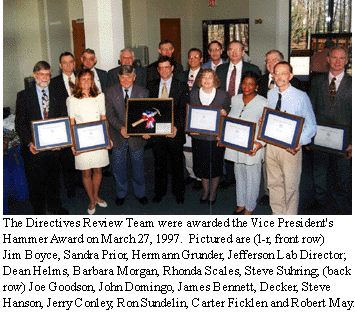 The team was initiated upon the request of the Jefferson Lab Director's Council.
The team was initiated upon the request of the Jefferson Lab Director's Council.
"The team evolved from the Work Smart Standards process that we had just finished completing, but we were requested by the Director's Council to actually look at the directives that were in our Performance Based Contract with DOE," said Jim Boyce, the Process Leader for the Directives Review Team.
Jim Decker, Deputy Director of DOE's Office of Energy Research, presented the Hammer Award, on behalf of the Clinton Administration, to the team at an award ceremony on March 27, 1997, at Jefferson Lab. "The Hammer Award is so named because it rewards efforts to weed out waste, like the infamous $600 government hammer. The mounted hammer on the award cost less than $6," said Decker.
Decker admitted that, although the regulations were implemented by well-meaning people, over the years they had become cumbersome. Prior to the new streamlined set of regulations, Jefferson Lab was required to follow the more than 1,500 requirements found in 31 EH&S related DOE orders. The goal of the Directives Review Team was to clearly define the requirements and expectations of the EH&S program, and tailor them to the specific mission and site characteristics of Jefferson Lab. The review team reached this goal in only six months.
In order to accomplish their task, a database was created to examine each EH&S requirement in the context of its use at Jefferson Lab. After a rigorous examination of each requirement the team would recommend its inclusion or exclusion in the Performance Based Contract between DOE and the Southeastern Universities Research Association, which manages Jefferson Lab.
The team members represent a cross-section of all the departments at Jefferson Lab and the Department of Energy. "We wanted a good cross-section of professional skills to examine the requirements," said Dean Helms, Site Manager for Jefferson Lab who represented DOE on the team. "We needed health and safety knowledge, technical skills, legal skills, and line managers to be involved because they are responsible for the work. We also wanted representatives from both the Laboratory and the site office." At the conclusion of the team's examination, it was determined that only nine percent of the existing requirements needed to be part of the contract. The remaining requirements were either already covered in law or regulation or simply did not apply to needs and circumstances present at Jefferson Lab. The end result of the review team's efforts was a smaller, tailored and unambiguous set of EH&S requirements that fit within the parameters of all Work Smart Standards. "I think the most important change I've seen as a result of the new regulations is the EH&S knowledge gained by the people who participated in this process," said Boyce. "Just as important is the fact that the site office's understanding of the work that we do has increased tremendously. The partnership between the site office and the Lab staff has improved one thousand percent."
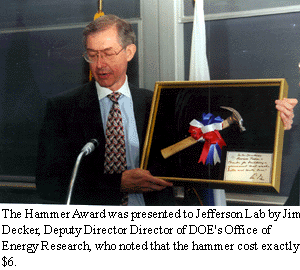 Although attempts had been made by others to simplify the EH&S requirements, this was the first time the effort was successfully completed. Boyce believes the Directives Review Team triumphed because it studied each requirement, not only on its individual usefulness, but also on the overall benefit it would bring to the Lab.
Although attempts had been made by others to simplify the EH&S requirements, this was the first time the effort was successfully completed. Boyce believes the Directives Review Team triumphed because it studied each requirement, not only on its individual usefulness, but also on the overall benefit it would bring to the Lab.
"I think the process could be applied at any large organization that is big enough to have several divisions or sites, and has a need for a cross-divisional team," said Boyce. "This process could help them streamline whatever bureaucratic process under which they operate." Boyce has lectured about the process to the Virginia Peninsula Total Quality Institute. DOE has also shown interest in using the process to revise their own accelerator safety orders so that each laboratory under DOE would have a set of orders tailored to the specific needs of that laboratory.
Helms nominated the Directives Review Team for the Hammer Award in November of 1996. "I believe the nomination had strong merit because it met the criteria of the Hammer Award, which is basically to streamline and reinvent processes, make them more cost effective, and deliver better service to customers," said Helms. "In this case customers could be outside users or it could be people in the laboratory - they are all customers of work that's done here."
In the past five years, the Hammer Award has been won by 27 teams within the Department of Energy. This was the first time Jefferson Lab submitted a nomination.
"We were virtually through the entire process before this award was mentioned as a possibility," said Boyce. "When the subject first came up I was surprised, I felt it was just a normal part of our job to try to make the way we do business better. But when I found out we had won, I was really surprised and excited."
CROSSING BOUNDARIES
Video conferencing allows students to take Michigan State courses
High technology knows no boundaries at Jefferson Lab. On Tuesday and Thursday it enters room L207 in CEBAF Center for an hour and 15 minutes. This technology is in the form of video conferencing-the wave of the future for interactive meetings and conferences when all participants cannot be in one location. For Jefferson Lab students, employees and users, video conferencing is allowing them to participate in an "Introduction to Beam Physics" class taught by Martin Berz of Michigan State University. The video conferencing is set up using PictureTel equipment, a system of telephones, cameras, and software. Participants see an image of the professor, hear his lecture, ask questions, and receive a "real time" response. The World Wide Web is used to post lecture notes and to distribute hand-outs and homework. Participation in the class includes 93 people from FermiLab, Los Alamos National Lab, Argonne National Lab, and Brookhaven Lab, as well as institutions in Canada and Europe and ranges from course credit to a certificate of participation. Jefferson Lab has 10 participants in the class.
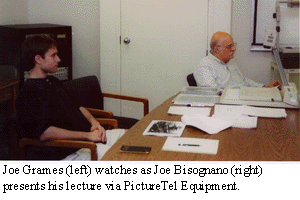 Joe Grames, a doctoral student at the Lab, heard about the class from his advisor at the University of Illinois and initiated the effort to bring the class to the Lab. "Coursework on beam and accelerator physics are not often available at the Lab, so when an opportunity like this arises, I jump at it," says Grames, who is investigating the transport of the polarized electron beam through the accelerator for his doctoral thesis. While the video conferencing is valuable for students who cannot attend the class in person, not being able to interact directly with a professor may present problems. Berz anticipated those problems and asked local accelerator physicists to serve as points of contact for help with homework and understanding lecture concepts.
Joe Grames, a doctoral student at the Lab, heard about the class from his advisor at the University of Illinois and initiated the effort to bring the class to the Lab. "Coursework on beam and accelerator physics are not often available at the Lab, so when an opportunity like this arises, I jump at it," says Grames, who is investigating the transport of the polarized electron beam through the accelerator for his doctoral thesis. While the video conferencing is valuable for students who cannot attend the class in person, not being able to interact directly with a professor may present problems. Berz anticipated those problems and asked local accelerator physicists to serve as points of contact for help with homework and understanding lecture concepts.
"In each lab, there are one or two experienced individuals serving as local contacts to help with organizational issues, course content, and homework," says Berz. Joe Bisognano and Johannes Van Zeijts of the Accelerator Division are the local accelerator physics contacts for the students. The accelerator experts also serve as guest speakers for the class, giving lectures on their areas of expertise. On February 27, Bisognano was a guest lecturer for the class, presenting information about the CEBAF accelerator. He enjoyed the opportunity to participate in the video conferencing and said, "This approach to accelerator education where lectures from around the world can be given as part of a university accelerator course is exciting."
The availability of video conferencing offers post-doctoral students, employees and users another option for increasing their knowledge of accelerator physics. According to Berz, "This concept offers an efficient and inexpensive mechanism to learn introductory material on accelerator physics in a systematic fashion, and offers the opportunity to earn college credit without leaving the workplace."
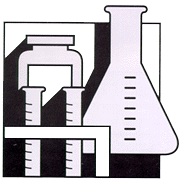 ON THE JOB SAFETY
ON THE JOB SAFETY
New policy works to prevent substance abuse
As drugs and alcohol become an increasing problem in the United States, the effects are being felt not only by individual users and their families, but also in the workplace. Staff members who abuse drugs and alcohol are often unable to check their problems at the door when they enter the workplace, leading to unsafe work habits, poor job performance, and damaged work relationships.
Safety
The physical and psychological effects of drugs and alcohol can interfere with concentration, vision, coordination, and motor control, resulting in accidents and injuries. There is increased risk when substance abusers work in an unsafe and careless manner, especially around heavy machinery, motor vehicles, electrical equipment, and potentially toxic materials. A recent study reports that substance abusers were 3.6 times more likely to injure themselves or another person in a work place accident.
Performance
Substance abuse may noticeably affect an employee's job performance. These performance levels can become erratic and unpredictable. Sometimes the substance abuser may be energetic to the point of workaholism to make up for the problem he or she is hiding. Over time, the quality of work declines, and the abuser becomes unreliable. Absenteeism and tardiness are a common problem, especially on Friday and/or Monday. Substance abusers may be absent from their desks or work areas frequently and may also leave work early. Research indicates that individuals who abuse substances are more likely to be injured off the job, which in turn affects attendance and performance on the job. Studies also report that each abuser costs an employer an average of 25 percent of the individual's salary in lost productivity. Substance abuse may ultimately result in the loss of employment.
Working Relationships
Substance abuse has a negative effect on the relationships an abuser has at work. Co-workers may be asked to complete the work of the abuser, especially when deadlines must be met. When individual performance levels diminish, team effectiveness also can be affected. Friction among workers may occur, resulting in low morale. Sometimes co-workers unwittingly attempt to help the substance abuser, but eventually everyone becomes uncomfortable with the situation, and a negative work environment develops over time. The ability to achieve objectives is impacted by this type of environment.
Jefferson Lab is committed to providing a productive and safe work environment. The Lab's Workplace Substance Abuse Program Policy provides a framework to achieve this objective through a workplace free of substance abuse. Effective February 1, 1997, this policy was revised to include drug and alcohol testing when probable cause exists. The revised policy, as well as the corresponding changes to the Employee Handbook, were distributed to staff members in mid-January. This information discusses situations which may result in drug and alcohol testing, and the testing procedures which will be followed.
Staff members are encouraged to seek early assessment and treatment of substance abuse problems before they become a workplace problem. The Lab offers an Employee Assistance Program (EAP) to help staff members and their families with substance abuse problems, as well as other personal and family problems. An EAP counselor can be contacted confidentially, 24 hours a day at 1-800-950-3434. In addition, the Lab's Medical Services staff is available to provide information on substance abuse and returning to high work performance levels. Any questions regarding the Lab's Workplace Substance Abuse Program can be directed to Lorraine Mahone, Employee Relations Manager, at X7232 or through e-mail at "mahone." Statistics from referenced studies in "What Every Employee Should Know About Drug Abuse," Institute for a Drug-Free Workplace, 1995.
BONNIE MADRE:
computer scientist, future pilot
Doctor. Lawyer. Teacher. Engineer. Finding the perfect job isn't easy. Just ask Bonnie Madre. The Jefferson Lab computer scientist has changed career fields several times in pursuit of a job that combines technical challenges and an interesting work environment, which she says has been found at Jefferson Lab.
"What I love about my job and the Lab is being a part of something that has never been done before," says Madre. "When you sit in a meeting after a milestone has been reached, you realize why you do this. When I program something, push a button on a screen, and something actually happens 25 feet underground, it's a little unnerving, but exciting." In 1992, Madre joined Jefferson Lab as a Computer Scientist and began working on programs that automate the devices that run the accelerator, such as the machine protection devices, which include the fast shutdown system, beam current monitors, and beam loss monitors.
"I work with a lot of devices that attempt to shut the machine down before there could possibly be damage to the machine," says Madre. "My programs come into play when the accelerator operators need to interface with the Machine Protection System - when they need to look at it, find out what failed, and solve the problem." Madre has also worked on programs that allow the accelerator operators to remotely open and close valves and monitor vacuum levels in the machine.
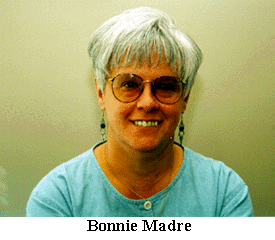 Madre's adventures began at Seton Hill College in Pennsylvania where she studied pre-medicine. She changed plans and used her degree in Biology to teach high school for two years. She then spent 15 years at a company that manufactured cutting, drilling, and mining tools. "While I was at this company I worked in the research lab doing things like scanning electron microscopy, and X-ray fluorescence and diffraction," says Madre. "Then I moved into information support where I was first introduced to computers." Madre's introduction to computers was a life-changing event. "I needed to determine some percentages and make some graphs for selective screening of fine powders and proportions of grit," says Madre. "I had previously been doing this process by hand, but found it to be too time-consuming. I noticed this computer at work that nobody was using and began reading up on computers. I wrote my first program in BASIC to display this graphic information. After this experience, I was hooked!" While just reading about computers was valuable to Madre at the time, she decided to pursue a career in computer programming and went back to school at the University of Pittsburgh. She received a Master's of Science Degree in Information Science in 1988.
Madre's adventures began at Seton Hill College in Pennsylvania where she studied pre-medicine. She changed plans and used her degree in Biology to teach high school for two years. She then spent 15 years at a company that manufactured cutting, drilling, and mining tools. "While I was at this company I worked in the research lab doing things like scanning electron microscopy, and X-ray fluorescence and diffraction," says Madre. "Then I moved into information support where I was first introduced to computers." Madre's introduction to computers was a life-changing event. "I needed to determine some percentages and make some graphs for selective screening of fine powders and proportions of grit," says Madre. "I had previously been doing this process by hand, but found it to be too time-consuming. I noticed this computer at work that nobody was using and began reading up on computers. I wrote my first program in BASIC to display this graphic information. After this experience, I was hooked!" While just reading about computers was valuable to Madre at the time, she decided to pursue a career in computer programming and went back to school at the University of Pittsburgh. She received a Master's of Science Degree in Information Science in 1988.
Throughout Madre's varied work experiences and other life challenges, she has remained grounded and optimistic, relying on advice her father gave her. "My dad told me, 'Do what you like to do and keep doing it. If someone tells you that you can't, ask them why. Chances are they won't have a good reason, and most of the time, you will have been doing it anyway.' These have been words that I have tried to live by," says Madre. Another dream that Madre is fulfilling is her love of aviation. Her office is adorned with several models and photographs of airplanes, including her 1956 Piper Tripacer airplane that she has painstakingly helped her husband restore. "Every inch of that plane has been hand polished and waxed," jokes Madre. Currently, she's just a passenger in the plane, but her husband won't be the only pilot in the family for long; Madre plans to begin flight lessons.
"There is no way to explain the pleasure I get from flying," says Madre. "You just have to get up in the air and see what an absolutely beautiful area this is to appreciate it."
UPDATE ON THE END STATIONS
HALL A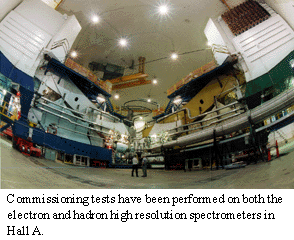 Almost all experiments in Hall A need both an electron spectrometer and a hadron spectrometer in order to run successfully. Although the electron spectrometer has been completed and ready for use in experimentation for some time, the hadron spectrometer developed what could have been a serious problem. The problem was discovered in the second week of December 1996, during the testing of the superconducting magnet inside the spectrometer. The superconducting magnet is an electromagnet which has four subcoils, two in the top half of the magnet and two in the bottom half of the magnet. The problem found was a copper short across one of the coils. Emergency tests were run to determine the affect of the short on the overall operation of the spectrometer. The results of those tests have shown that the spectrometer can be efficiently operated, with the presence of the short, if the power supply is ramped up and down at slow speed. The changes to the power supply have been made, and the first five approved experiments in Hall A should run on time.
Almost all experiments in Hall A need both an electron spectrometer and a hadron spectrometer in order to run successfully. Although the electron spectrometer has been completed and ready for use in experimentation for some time, the hadron spectrometer developed what could have been a serious problem. The problem was discovered in the second week of December 1996, during the testing of the superconducting magnet inside the spectrometer. The superconducting magnet is an electromagnet which has four subcoils, two in the top half of the magnet and two in the bottom half of the magnet. The problem found was a copper short across one of the coils. Emergency tests were run to determine the affect of the short on the overall operation of the spectrometer. The results of those tests have shown that the spectrometer can be efficiently operated, with the presence of the short, if the power supply is ramped up and down at slow speed. The changes to the power supply have been made, and the first five approved experiments in Hall A should run on time.
The commissioning test of the hadron spectrometer have been successfully completed, and indicates that the focusing properties are basically identical to those of the electron spectrometer. First coincidence tests have been carried out with both spectrometers. A preliminary analysis has shown that timing and energy spectra are consistent with the expectations of the accelerator operations team.
HALL B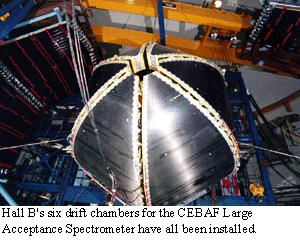 The construction of Hall B is essentially complete. A successful run has shown that most of the detectors are operating as they were designed to. Tests on the Cerenkov detectors have shown special sources of background radiation in the detector. Tests are being run to determine the cause of the radiation and how it will affect the operation of the detector. Unlike the other two Halls, which have detectors that sit approximately 50 to 80 feet from the target, Hall B will surround the target with the six detectors of the acceptance spectrometer. This will allow for more precise data collection. It will also create a challenge for the Accelerator Division. Because the detectors in Hall B are located in such close proximity to the target, the hall will require about one thousand times less beam current than Halls A and C. Yet the beam must be delivered to all halls simultaneously. This is a problem that has been anticipated for quite some time, and judging from the data received from the Hall's first beam the Accelerator Division has everything under control.
The construction of Hall B is essentially complete. A successful run has shown that most of the detectors are operating as they were designed to. Tests on the Cerenkov detectors have shown special sources of background radiation in the detector. Tests are being run to determine the cause of the radiation and how it will affect the operation of the detector. Unlike the other two Halls, which have detectors that sit approximately 50 to 80 feet from the target, Hall B will surround the target with the six detectors of the acceptance spectrometer. This will allow for more precise data collection. It will also create a challenge for the Accelerator Division. Because the detectors in Hall B are located in such close proximity to the target, the hall will require about one thousand times less beam current than Halls A and C. Yet the beam must be delivered to all halls simultaneously. This is a problem that has been anticipated for quite some time, and judging from the data received from the Hall's first beam the Accelerator Division has everything under control.
HALL C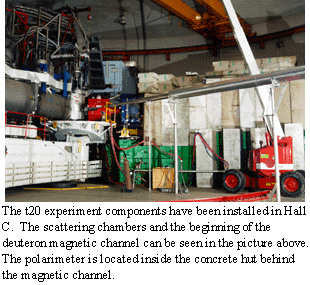 The t20 experiment began in April and will run through the first week in September, with a scheduled month-long break in July. Installation for the experiment, which will measure deuteron tensor polarization, began in early January. The experiment will use the High Momentum Spectrometer (HMS), but will not use the Short Orbit Spectrometer. There will be a second spectrometer used in coincidence with the HMS. It is made with normal magnets as opposed to superconducting magnets, and has three quadropoles and one dipole. The dipole, which is a bending magnet, separates the different momentum particles. At the same time the quadropoles, which are focusing magnets, make the acceptance look bigger in order to collect more particles. At the end of the spectrometer arm will be a polarimeter called Poldar. This polarimeter will examine the secondary deuterons (lightly bound combinations of one proton and one neutron) coming from a target. Two targets will be used in the experiment, one deuterium target and one hydrogen target. The targets will be involved in two interactions. First, the particles will interact with the deuterium target, the deuterium that expels from that target will then interact with the hydrogen target. At this point the dispersing electrons will move into the HMS and the dispersing deuterons will go into the Poldar assembly. This type of experimentation is known as a double scattering experiment. Measurements for the experiment will be taken by processing the differences in the particles that scatter out of deuterium target and the particles that scatter out of the hydrogen target.
The t20 experiment began in April and will run through the first week in September, with a scheduled month-long break in July. Installation for the experiment, which will measure deuteron tensor polarization, began in early January. The experiment will use the High Momentum Spectrometer (HMS), but will not use the Short Orbit Spectrometer. There will be a second spectrometer used in coincidence with the HMS. It is made with normal magnets as opposed to superconducting magnets, and has three quadropoles and one dipole. The dipole, which is a bending magnet, separates the different momentum particles. At the same time the quadropoles, which are focusing magnets, make the acceptance look bigger in order to collect more particles. At the end of the spectrometer arm will be a polarimeter called Poldar. This polarimeter will examine the secondary deuterons (lightly bound combinations of one proton and one neutron) coming from a target. Two targets will be used in the experiment, one deuterium target and one hydrogen target. The targets will be involved in two interactions. First, the particles will interact with the deuterium target, the deuterium that expels from that target will then interact with the hydrogen target. At this point the dispersing electrons will move into the HMS and the dispersing deuterons will go into the Poldar assembly. This type of experimentation is known as a double scattering experiment. Measurements for the experiment will be taken by processing the differences in the particles that scatter out of deuterium target and the particles that scatter out of the hydrogen target.
BRIEFLY...
MENTORS AND PROJECTS NEEDED
Is there data that needs to be analyzed, some research that needs to be done, or some other project that is math, science, or technology-based that needs to be completed but never seems to make it to the top of the priority list? If so, the solution may be to hire a student and/or teacher for the summer.
The Education Group has a pool of highly-motivated, intelligent high school students and exceptional high school teachers who are willing and able to assist this summer in completing projects. Some of the projects last year's students completed include:
- applying the C programming language to study electron polarization;
- developing test plans addressing radio-frequency (RF) studies;
- programming graphical user interfaces to monitor accelerator activity;
- designing vacuum control units to prevent cryomodule leakage;
- designing software to support the Free Electron Laser
Some of the projects last year's teachers completed include:
- collecting and analyzing data from the magnet test stands;
- producing interactive WWW-based pages for access into the Artemis on-line accelerator beamline simulation;
- designing and testing systems to semi-automatically control the positioning and measurement components of high resolution spectrometers in Hall A;
- devising a neutralization/metals precipitation procedure to remove metals and acid from wastewater streams;
- designing and constructing a bulk radiation waste counter
The programs begin June 23, 1997 and run through August 22, 1997. The students are expected to work approximately eight weeks, and the teachers are expected to work approximately five weeks. If this sounds like something you'd be willing to do to enhance and enrich a student and/or teacher's academic career by exposing them to a research and/or engineering environment, please contact Janet Tyler at X-7164 or by email at tyler@jlab.org. Your continued support is what keeps the education programs running!
UNDERGRADUATE SUMMER PROGRAM BEGINS JUNE 2
Now in its third year, the Jefferson Lab Undergraduate Physics Researchship program has accepted applications for summer placement within the Lab. The summer program offers promising physics students real world experience in a laboratory setting. The selection process has been completed and the nine selected students are currently being notified. The program begins on June 2 and the students will be on site for eight to 12 weeks working with physicists in the experimental halls.
WEEKLY POST-LUNCH MIXER AIMS TO FOSTER COMMUNICATION
Cookies and conversation will be the main attraction at a new activity being sponsored by the Director's Council. With a goal to promote interdivisional communication, a Post-Lunch Mixer is being held from 12:30 to 1:30 p.m. each Wednesday. Cookies and beverages are on the menu, with plenty of conversation expected on the side. Everyone across the laboratory is invited to attend. The first one will be held on April 23, 1997, in the CEBAF Center Atrium.
CULTURAL CELEBRATION
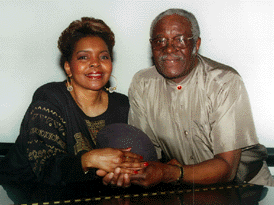 Diversity, heritage, and culture were celebrated at Jefferson Lab on February 26, 1997, at the Annual Black History Month Celebration. Weeks of planning by the Black History Month Planning Committee culminated in the afternoon event featuring music, food, and cultural artifacts.
Diversity, heritage, and culture were celebrated at Jefferson Lab on February 26, 1997, at the Annual Black History Month Celebration. Weeks of planning by the Black History Month Planning Committee culminated in the afternoon event featuring music, food, and cultural artifacts.
Employees were treated to a jazz session with the great Connie Parker and her partner on bass, Eddie Edwards. Parker and Edwards are renowned performers throughout Hampton Roads and treated the audience to old favorites like "Green Dolphin Street." Following the show, employees enjoyed cultural dishes, such as Phil Adderley's Caribbean Chicken Souse and Mary Beth Stewart's Polish Cabbage and Noodles. Several employees displayed their personal collections of African artifacts and wore traditional African clothing.
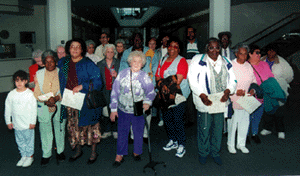 The Lab also hosted two groups of senior citizens from Hidenwood Retirement Community and Lexington Commons Retirement Community. The groups participated in a driving tour of the site and joined the staff for the concert and food. Thanks to the planning committee for a job well done!
The Lab also hosted two groups of senior citizens from Hidenwood Retirement Community and Lexington Commons Retirement Community. The groups participated in a driving tour of the site and joined the staff for the concert and food. Thanks to the planning committee for a job well done!
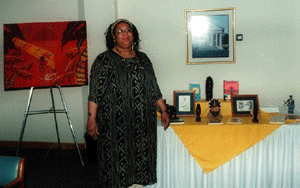 |
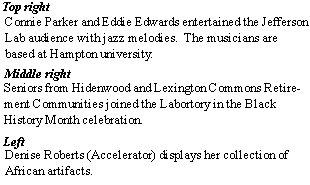 |
FIRST BENEFITS FAIR A SUCCESS
As part of an effort to keep in touch with the needs of Jefferson Lab employees, the Human Resources and Services department sponsored the first Benefits Fair. The fair took place March 13 and 14 in the VARC building lobby, and featured eleven companies that provide benefits to the Lab. "We wanted the fair to be mostly an informational session for the Lab staff members, so they could have the opportunity to ask various questions of the venders who provide our benefits here at the Lab," said Milton Brooks, Manager for Compensation and Benefits.
Brooks adds that many employees knew the basic information about their benefits, but still had individual concerns they wanted answered. "This was an opportunity for employees to be exposed to the people who actually provide those benefits and services," said Brooks. In addition to the major benefit providers, like Blue Cross Blue Shield and Delta Dental, the fair also featured Sam's Club, Price Club, and Riverside Wellness and Fitness Center.
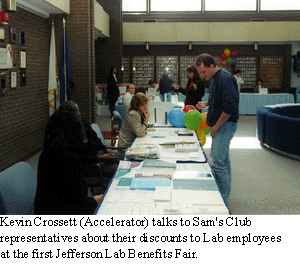 "The regular and term employees are eligible for the medical and dental care, but any casual employee, student intern, or foreign visitor can receive the benefits from the other companies," said Stacey Crane, Benefits Administrator Representative.
"The regular and term employees are eligible for the medical and dental care, but any casual employee, student intern, or foreign visitor can receive the benefits from the other companies," said Stacey Crane, Benefits Administrator Representative.
"As a casual employee I don't receive any health or medical benefits. The fact that places like Sam's Club are here gives me something to look forward to and peruse," said Philis McKear, Occupational Health Nurse. " I think it's great."
The planners of the fair hope to make it a yearly event. "This is our first benefits fair, and whether we have another will depend on how well the employees enjoyed the fair this year. Hopefully we'll be able to have it every year," said Crane.
Approximately 203 employees attended the event. Janice Walston, a buyer in the Procurement Department, enjoyed the fair. "I think it's great that the individual companies came to us," she said. "Many times people have questions, but don't have the time to call the company. This way you can just talk to them at your own leisure. I like that." Several door prizes, including Jefferson Lab Polo shirts, mugs, ties, T-shirts, and AMC Movie tickets, were donated by the Director's Office and the Jefferson Activities Group. Two drawings were held each half hour, awarding a total of 34 door prizes.
LABORATORY RECEIVES CHOICE AWARD
Jefferson Lab is the recipient of the American Red Cross Choice Award. The Choice Award is given to a sponsoring group which exhibits commitment and understanding of the American Red Cross mission, and who constantly meets and exceeds that goal.
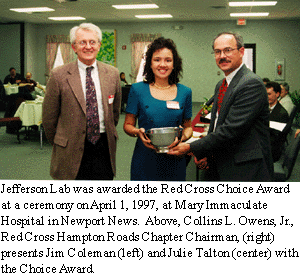 Jim Coleman, Associate Director for the Administration Division, and Julie Talton, Medical Services secretary, accepted the Choice Award, on behalf of Jefferson Lab, at the Hampton Roads Chapter 28th Annual Bloodmobile Sponsor Luncheon.
Jim Coleman, Associate Director for the Administration Division, and Julie Talton, Medical Services secretary, accepted the Choice Award, on behalf of Jefferson Lab, at the Hampton Roads Chapter 28th Annual Bloodmobile Sponsor Luncheon.
The luncheon, hosted by Mary Immaculate Hospital on April 1, featured guest speaker Christopher Murphy, Pharmacy Coordinator for the Bone Marrow Transplant/Oncology Program at Riverside Regional Medical Center. Murphy thanked organizations, like Jefferson Lab for showing support by holding blood drives. He also stressed the importance of giving blood, and pointed out that he has seen first hand how donated blood can save lives. Jefferson Lab held its first blood drive November 2, 1988. In that first drive the Lab exceeded its quota of 65 donors by 55 percent. The Lab now holds blood drives twice a year, and with each year the quota for donors increases. "Since 1995, the quota has risen from 65 to 75, and Jefferson Lab has consistently surpassed each quota," says Talton.

